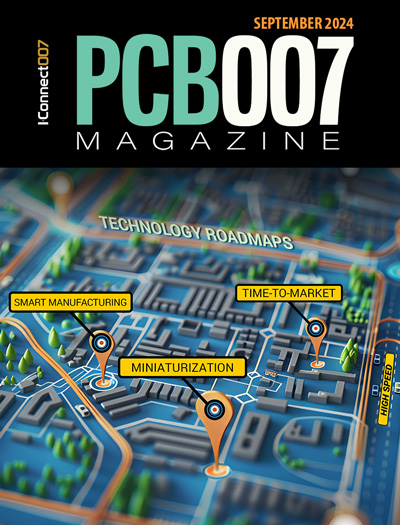-

- News
- Books
Featured Books
- pcb007 Magazine
Latest Issues
Current Issue
Engineering Economics
The real cost to manufacture a PCB encompasses everything that goes into making the product: the materials and other value-added supplies, machine and personnel costs, and most importantly, your quality. A hard look at real costs seems wholly appropriate.

Alternate Metallization Processes
Traditional electroless copper and electroless copper immersion gold have been primary PCB plating methods for decades. But alternative plating metals and processes have been introduced over the past few years as miniaturization and advanced packaging continue to develop.

Technology Roadmaps
In this issue of PCB007 Magazine, we discuss technology roadmaps and what they mean for our businesses, providing context to the all-important question: What is my company’s technology roadmap?
- Articles
- Columns
Search Console
- Links
- Media kit
||| MENU - pcb007 Magazine
An Update on USPAE's Strategic Initiatives
November 12, 2024 | Marcy LaRont, I-Connect007Estimated reading time: 9 minutes
LaRont: What were the big takeaways?
Will: There were a couple of takeaways. Because it was so well attended, attendees had the opportunity to interact with a large contingent from microelectronics, including international stakeholders. I received feedback that there was a lot of opportunity for networking which was appreciated, especially the government and DIB stakeholders which is, by its nature, more relational compared to commercial focused interests. I heard from several defense contractors who commented that they had a lot of time to meet and network.
LaRont: What is your role as a member of the IMAPS executive council?
Will: I am one year into my two-year director role. My focus areas are U.S. government and defense, and I lead a committee in that regard through IMAPS. We are planning next year’s Onshoring Workshop at the Sheraton Pentagon City Hotel. I also help with workforce development associated to U.S. government interests. There are so many initiatives, including ME Commons hubs, NSTC Workforce Center of Excellence, NSF/DOC National Network for Microelectronics Education Program, and more.
LaRont: What’s next on the agenda for USPAE?
Will: We are focusing on our signature programs including the defense business accelerator (DBX) microelectronics challenge and cluster accelerator conceived by the DoD's MCEIP office in partnership with the USPAE and ATI. We continue to focus on opportunities to be more proactive in identifying business opportunities for alliance partners to address supply chain assurance and resiliency needs, including assembling and leading teams to address government and industry challenges.
The DBX cluster is very interesting. We were aware that companies within a geographic region existed. Particularly when competing against much more significant Chinese investments, we want to understand and model clusters considering many factors that range from workforce to security, childcare, and transportation. Clusters are exemplars from which to promote industry and assured supply chains.
These DBX programs have been performing well and are approaching conclusions. We are ready to support follow-on programs which will depend on direction from our government sponsors’ strategic plans.
We already addressed critical infrastructure strategy, and have “technology refresh” on the list. There are ongoing investments in microelectronic infrastructure and capabilities as result of CHIPS and many other programs. This provides opportunity to leverage that capability to refresh technologies in the Defense Industrial Base and in Critical Infrastructure. There are many approaches as part of a “toolbox” concept.
For example, one approach considers disaggregation into chiplets, which enables combining different functional blocks leveraging more advanced packaging approaches to provide a component—perhaps an FPGA, memory, and other chiplets, depending on application, to create a component that may be new or replace a component in older technology with a much less resilient supply or only available from one source.
This may include leveraging the infrastructure and technology capabilities to attach the chiplets onto an UHDI board or substrate, perhaps glass for RF applications, and package into BGA or other finish depending on system needs to realize a component to support a technology refresh while addressing supply chain assurance and resiliency needs. Those are just a couple of examples. We need to flush out and find opportunities to exercise the toolbox as part of a technology refresh strategic and program.
LaRont: Adding Critical Infrastructure into the mix has huge implications and the cluster programs are very interesting.
Will: We are working on a Critical Infrastructure paper as well as a paper with NDIA advising on industry-based assurance standards. There is a lot happening and we are just getting started. This is a very exciting time to be part of the microelectronics and electronics industry.
LaRont: Jim, it’s a pleasure talking to you. I wish you continued luck in all your pursuits, and for the betterment of us all. Thanks for your time.
Will: Thank you, Marcy.
Page 2 of 2Suggested Items
I-Connect007 Editor’s Choice: Five Must-Reads for the Week
11/22/2024 | Andy Shaughnessy, I-Connect007In this week’s roundup, I’m highlighting a variety of articles. We have an interview with Jess Hollenbaugh, a recent graduate working for Polar Instruments. We also have an interview with IPC’s Matt Kelly and Devan Iyer, whose white paper may provide a way forward for companies dealing with complex advanced packages. Our newest columnist Tom Yang describes the U.S. PCB industry from the point of view of a technologist from another country, and Dan Beaulieu has a review of Malcolm Gladwell’s follow-up to The Tipping Point. Finally, we have my review of PCB Carolina, a one-day tabletop show that keeps expanding, much like my waistline after eating their catered food. Enjoy!
Western Digital CEO David Goeckeler Elected Chair of Semiconductor Industry Association
11/22/2024 | SIAThe Semiconductor Industry Association (SIA) today announced Western Digital CEO David Goeckeler has been elected Chair of the SIA Board of Directors. SIA represents 99% of the U.S. semiconductor industry by revenue and nearly two-thirds of non-U.S. chip firms.
Meet Polar's New Product Specialist Jess Hollenbaugh
11/21/2024 | Andy Shaughnessy, I-Connect007At PCB West, I spoke with Jess Hollenbaugh, a recent college graduate who has now joined Polar Instruments. In this interview, she shares her journey from a physics student focused on high-energy astrophysics to her new role at Polar. Her insights provide a glimpse into the dynamic opportunities awaiting those who venture into this evolving industry.
SIA Applauds CHIPS Award for Semiconductor Research Corporation’s SMART USA Institute
11/21/2024 | SIAThe Semiconductor Industry Association (SIA) released the following statement from SIA President and CEO John Neuffer commending the announcement that the U.S. Department of Commerce and the Semiconductor Research Corporation Manufacturing Consortium Corporation (SRC) are entering negotiations for the Commerce Department to provide SRC $285 million to establish and operate the CHIPS Manufacturing USA Institute for Digital Twins.
IPC Issues Clarion Call for EU to Reclaim Leadership in Electronics Manufacturing
11/21/2024 | IPCIPC released a synopsis of its recent white paper, Securing the European Union’s Electronics Ecosystem. This condensed document presents a comprehensive overview of the current challenges in Europe’s electronics manufacturing industry and shares actionable steps to help the EU achieve a stronger, more autonomous ecosystem.


